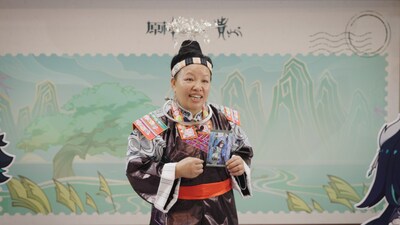GUIYANG, China, Aug. 28, 2025 /PRNewswire/ — A news report by Huanqiu.com
The “game + culture” cross-border experiment between the open-world adventure RPG Genshin Impact and Guizhou has amplified the charm of Guizhou’s intangible cultural heritages. According to Ma Yi, a municipal representative inheritor of Daloushan rattan weaving, an intangible cultural heritage program, such interactive event is of milestone significance for the inheritance and development of the intangible cultural heritages in Guizhou. It opens a door towards the youth world, broadens the path of passing down intangible cultural heritages, and finds a new foothold for the ancient intangible cultural heritages amid the development wave of contemporary technology and culture.
The Miao batik technique has amazed and attracted young game players. The virtual rattan weaving product made by the game character “Lan Yan” and the physical rattan weaving artworks from the intangible cultural heritage inheritor of Guizhou are presented here to start a cultural dialogue beyond temporal and spatial boundaries. “I was very expected and pleased when learning that Genshin Impact, a video game highly popular among the young generation intended to collaborate with Guizhou’s intangible cultural heritages, because it gives me a new hope of witnessing the rejuvenation of traditional skills and techniques in the new era”, commented by Ma Yi.
When playing the game of Genshin Impact, players have come to know and love the batik art, an intangible cultural heritage of Guizhou. The Miao people ingeniously apply two colors, blue and white to printing patterns including butterfly, bird and dragon on plain cloth. Cheng Hao, a batik designer explained, “In addition to its artistic value, Miao batik has recorded the long history of the Miao ethnic group. Nowadays, we integrate these batik elements into our designs, hoping to carry forward the intangible cultural heritage.”
Cheng Hao had lived with female batik workers in Danzhai, Guizhou for eight years. In his opinion, the Miao culture purifies his mind and enriches his inspirations by reflecting the simple and unadorned worldview of Miao locals. When creating batik patterns, designers must truly understand their batik partnering workers as if they are family members, so as to better present their creative concepts and finally work out excellent fashion design of batik.
“For example, we have an artwork called Returning to the Dreamlike Peach Blossom Spring. At the very beginning, the batik worker did not know what the Peach Blossom Spring is. Then we told her the story of Tao Yuanming, a literatus of the Eastern Jin Dynasty, and she created the beautiful patterns according to her own distinct understanding.” Cheng Hao expressed that the final works delicately depicts the life scenes of raising silkworms, weaving cloth and spinning yarns, and also contains some ancient totems such as flowers, birds, fish and insects commonly-seen in life, and geometric patterns as well.
In addition to batik, Miao embroidery is another unique carrier of the charming intangible cultural heritage. “This is the pattern of Mom Butterfly. The patterns of Miao embroidery not only show the totem worship of Miao people, but also deliver rich historical and cultural messages of the Miao ethnic group, such as butterfly.” Li Wenfang, an inheritor of Miao embroidery, shared the cultural origin of Miao embroidery patterns. According to the ancient myths described in the Ancient Odes of the Miao People passed down through generations, the “Mom Butterfly” fell in love with foam on the water surface, and laid 12 eggs, which later hatched the ancestors of all things in the world.
Miao embroidery displays the superior craftsmanship of Miao people, and embodies their expectations for a better life. Every stitch of Miao embroidery epitomizes the respect for the nature and anticipation for the future. Li Wenfang explained that among these patterns, pomegranate symbolizes good fortune and fertility, fish metaphorizes prosperity and vigorous vitality, and dragon can be classified into swimming dragon, flying dragon and other types. The elder Miao people have been passing on the cultural symbols and historical stories in the form of Miao embroidery patterns for the relay of the traditional culture and wisdom of the Miao ethnic group.
Yang Naijin, an inheritor of the intangible cultural heritage of batik further elaborated on the making process of batik. It mainly uses natural materials like beeswax and indigo plant. Beeswax is applied to drawing patterns and preventing dyeing, while indigo plant to dyeing. After the steps of drawing patterns, applying beeswax, dyeing and removing beeswax, unique blue-and-white patterns are formed at the end.
“The combination of family inheritance and modern design leads to the revival of the batik art in the new era, particularly in such fields as games and fashion design.” Yang Naijin mentioned that batik patterns can be applied more to cartoons and games popular among young people in the future. For instance, Genshin Impact and batik have collaborated in Guizhou, allowing these young people to experience and learn the batik art, and create their favorite batik works. Batik can be further applied to decorative items, scarves, bags, and even interior decoration in the form of murals, showcasing the Miao style and carrying forward the intangible cultural heritage.



